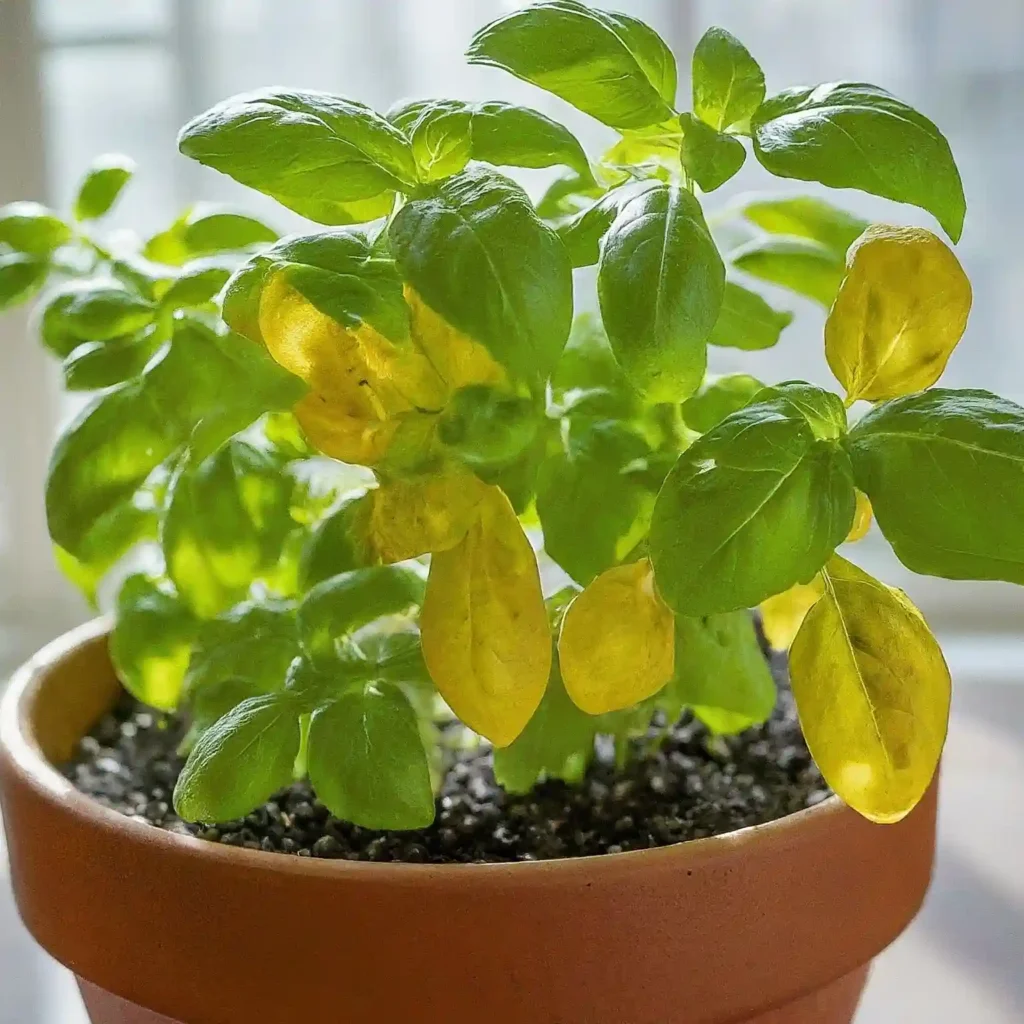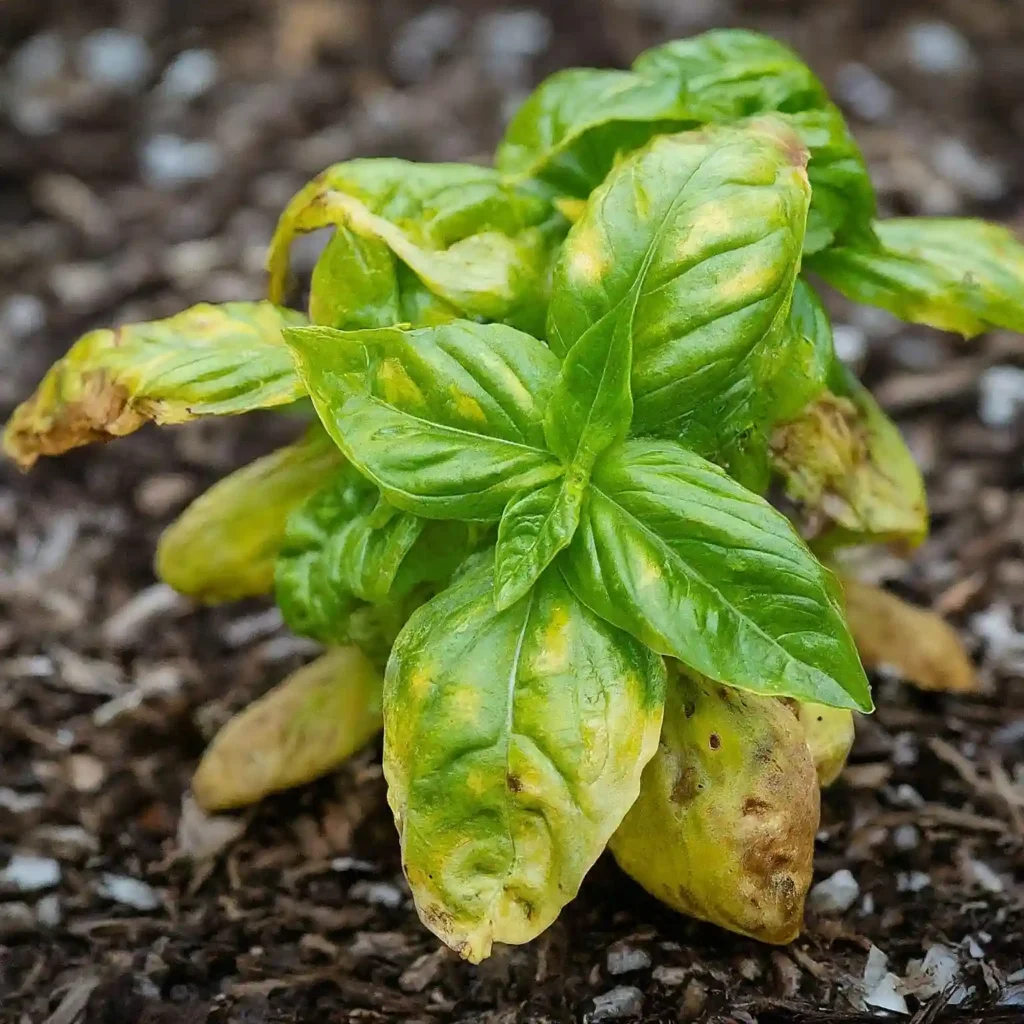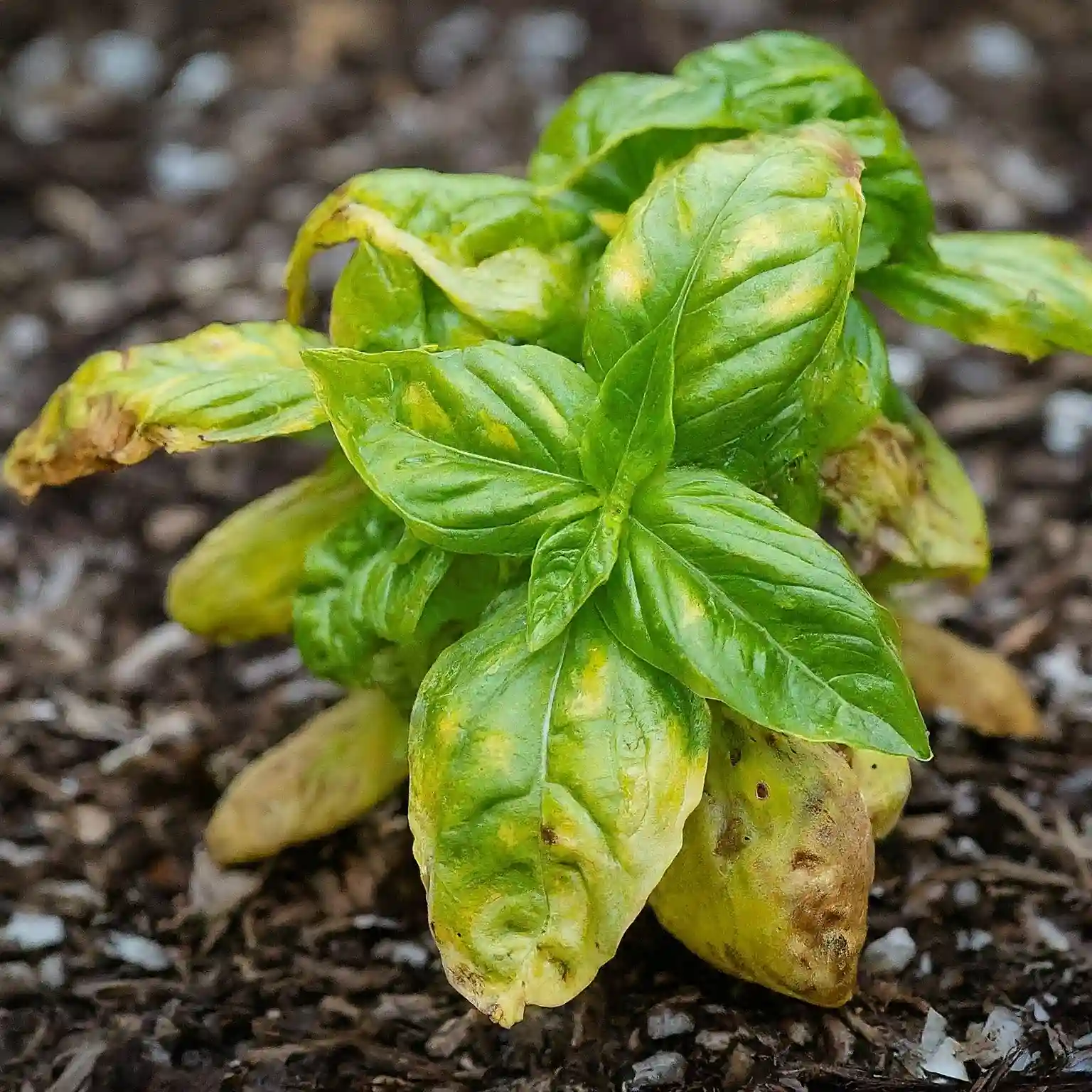Basil Plant Care Yellow Leaves
Yellow leaves on a basil plant can indicate various issues. Here are some common causes and solutions:
- Nutrient deficiency: Basil plants require nitrogen, phosphorus, and potassium. Yellowing leaves can indicate a deficiency in any of these nutrients. Fertilize the plant with a balanced fertilizer.
- Overwatering: Excess water can suffocate the roots and cause yellowing leaves. Allow the soil to dry slightly between waterings.
- Underwatering: Basil plants need regular watering, especially during hot weather. Water the plant deeply when the soil is dry to the touch.
- Sunburn: Basil plants prefer partial shade. Too much direct sunlight can scorch the leaves and cause them to turn yellow.
- Pests: Spider mites and aphids can feed on basil leaves, causing them to turn yellow. Use an insecticidal soap to control pests.

Why Basil Leaves Turn Yellow
Basil is a popular herb that’s easy to grow, but it can sometimes develop yellow leaves. This can be frustrating, but don’t worry – it’s usually not a sign of a serious problem.
There are several reasons why basil leaves might turn yellow. One common cause is nutrient deficiency. Basil plants need a lot of nitrogen, so if your plant isn’t getting enough, its leaves may start to turn yellow.
Another common cause of yellowing basil leaves is overwatering. Basil plants don’t like to sit in wet soil, so if you’re watering them too often, their roots may start to rot. This can lead to yellowing leaves and other problems.
Underwatering can also cause basil leaves to turn yellow. Basil plants need regular watering, especially during hot weather. If your plant isn’t getting enough water, its leaves may start to wilt and turn yellow.
Pests and diseases can also cause basil leaves to turn yellow. If you see any pests or signs of disease on your basil plant, treat it with an appropriate pesticide or fungicide.
Finally, environmental factors can also cause basil leaves to turn yellow. Basil plants prefer warm, sunny weather. If your plant is exposed to too much cold or shade, its leaves may start to turn yellow.

How to Fix Yellowing Basil Leaves
If your basil leaves are turning yellow, there are a few things you can do to try to fix the problem.
First, check the soil moisture. Basil plants need to be watered regularly, but they don’t like to sit in wet soil. If the soil is too wet, the roots can rot and the plant will start to wilt. If the soil is too dry, the leaves will turn yellow and crispy. Water the plant when the soil is dry to the touch, and make sure to drain any excess water from the pot.
Next, check the sunlight. Basil plants need plenty of sunlight to grow properly. If the plant is not getting enough sunlight, the leaves will turn yellow and the plant will be stunted. Move the plant to a sunnier location, or provide supplemental lighting.
Finally, check for pests or diseases. Pests and diseases can cause the leaves of basil plants to turn yellow. Inspect the plant carefully for any signs of pests or diseases, and treat the plant accordingly.
If you have tried all of these things and the leaves of your basil plant are still turning yellow, you may need to consult with a plant expert. There may be an underlying problem that is causing the leaves to turn yellow, and a plant expert can help you to identify and fix the problem.
Yellow Leaves on Basil Plants: Causes and Solutions
Basil leaves turning yellow can be a sign of various factors affecting the plant’s health. Here are some common causes and potential solutions:
Nutrient Deficiencies: Basil plants require specific nutrients for healthy growth. Nitrogen deficiency can lead to yellowing leaves, especially the older ones. Potassium deficiency can also cause yellowing and brown leaf edges. To address nutrient deficiencies, fertilize the plant with a balanced fertilizer.
Overwatering: Excessive watering can lead to root rot, which restricts the plant’s ability to absorb nutrients and water. Overwatered basil plants may have yellowing leaves, wilting, and soft stems. Allow the soil to dry out between waterings and avoid overwatering.
Underwatering: Basil plants also need adequate moisture to thrive. Underwatered plants may show signs of yellowing leaves, wilting, and dry soil. Water the plant deeply and regularly, especially during hot and dry weather.
Pests and Diseases: Pests such as aphids, whiteflies, and spider mites can feed on basil leaves, causing yellowing and discoloration. Diseases like basil downy mildew and fusarium wilt can also lead to yellowing leaves. Inspect the plant for pests or signs of disease and treat accordingly.
Environmental Factors: Basil plants prefer warm temperatures and plenty of sunlight. Exposure to cold temperatures or insufficient sunlight can cause yellowing leaves. Ensure the plant is in a warm location with adequate sunlight.
Other Causes: Transplant shock, root damage, or herbicide exposure can also contribute to yellowing basil leaves. Hardening off plants before transplanting and avoiding root damage can help prevent transplant shock. Inspect the plant for any physical damage or herbicide exposure and address the underlying issues.
Basil Plant Troubleshooting: Yellow Leaves
Yellowing leaves on basil plants can be a frustrating problem, but it’s often a sign of a correctable issue. By understanding the common causes of yellowing leaves, you can take the necessary steps to restore your basil plant to health.
Some of the most common causes of yellowing basil leaves include:
- Nutrient deficiencies, particularly nitrogen and potassium
- Overwatering or underwatering
- Insufficient sunlight
- Pests or diseases
- Transplant shock
- Root damage
To troubleshoot yellowing basil leaves, start by examining the plant carefully. Look for signs of pests or diseases, such as aphids, whiteflies, or powdery mildew. Check the soil moisture level to ensure that the plant is not overwatered or underwatered. If the soil is too dry, water the plant deeply. If the soil is soggy, allow it to dry out before watering again.
If you don’t see any signs of pests or diseases and the soil moisture level is correct, the next step is to consider nutrient deficiencies. Basil plants need a balanced fertilizer to thrive. If the plant is not getting enough nutrients, the leaves may turn yellow. Fertilize the plant with a balanced fertilizer according to the package directions.
If you have tried all of the above steps and the basil leaves are still yellow, you may need to consult with a plant expert or your local nursery for further assistance.
Nutrient Deficiencies
Nutrient deficiencies can cause basil leaves to turn yellow. The most common nutrient deficiencies that affect basil plants are nitrogen, potassium, and magnesium. Nitrogen deficiency can cause the leaves to turn pale green or yellow, and the plant may also have stunted growth. Potassium deficiency can cause the leaves to turn yellow or brown around the edges, and the plant may also wilt. Magnesium deficiency can cause the leaves to turn yellow between the veins, and the plant may also have stunted growth.
To correct a nutrient deficiency, you can fertilize your basil plant with a balanced fertilizer that contains nitrogen, potassium, and magnesium. You can also add compost or manure to the soil to provide additional nutrients.
Overwatering
Excessive watering can lead to waterlogged soil, which deprives the roots of oxygen and nutrients. This can cause the leaves to turn yellow and eventually drop off. To prevent overwatering, allow the soil to dry out slightly between waterings. Stick your finger about an inch into the soil; if it feels moist, wait a few more days before watering. You can also use a moisture meter to measure the soil moisture level.
If you have overwatered your basil plant, you can try to save it by repotting it into fresh, well-draining soil. Be sure to remove any damaged roots before repotting. Water the plant sparingly and allow the soil to dry out completely between waterings.
Underwatering
Basil plants require consistent moisture to thrive. When the soil is allowed to dry out completely, the plant will start to wilt and the leaves will turn yellow. To prevent underwatering, water your basil plant deeply and regularly, especially during hot and dry weather. Allow the top inch or two of soil to dry out before watering again.
Here are some signs that your basil plant may be underwatered:
- The leaves are wilted and dry.
- The soil is dry to the touch.
- The plant is stunted and not growing well.
If you think your basil plant is underwatered, water it deeply and immediately. Then, monitor the plant closely and water it regularly to prevent the problem from recurring.
Pests and Diseases
Pests and diseases can also cause basil leaves to turn yellow. Common pests that affect basil include aphids, spider mites, and whiteflies. These pests feed on the plant’s sap, which can lead to yellowing and wilting leaves. Diseases that can cause yellowing leaves in basil include basil downy mildew, basil wilt, and fusarium wilt. These diseases are caused by fungi or bacteria that can damage the plant’s vascular system or roots.
To prevent pests and diseases, keep your basil plants clean and free of debris. Water your plants at the base to avoid getting the leaves wet, as this can create a favorable environment for fungal growth. If you do find pests or diseases on your basil plants, treat them immediately with an appropriate pesticide or fungicide.
Environmental Factors
In addition to nutrient deficiencies and watering issues, environmental factors can also contribute to yellowing basil leaves:
- Temperature: Basil prefers warm temperatures between 65-85°F (18-29°C). Extreme cold or heat can cause leaves to turn yellow.
- Humidity: Basil thrives in humid environments. Dry air can lead to leaf yellowing and wilting.
- Light: Basil requires ample sunlight for optimal growth. Insufficient light can result in pale or yellow leaves.
- Wind: Strong winds can damage basil leaves, causing them to turn yellow and dry out.
To address these environmental factors, consider the following:
- Protect basil plants from extreme temperatures by providing shade or bringing them indoors during cold snaps.
- Increase humidity by misting basil leaves or using a humidifier.
- Provide adequate sunlight by placing basil plants in a sunny location or under grow lights.
- Shelter basil plants from strong winds by growing them in a sheltered area or using windbreaks.
Other Causes
In addition to the primary causes discussed above, there are a few other factors that can contribute to yellowing basil leaves:
1. Transplant Shock: When basil plants are transplanted from one location to another, they may experience transplant shock, which can cause temporary yellowing of the leaves. This is usually temporary and will resolve on its own within a few days to weeks.
2. Root Damage: Damage to the roots of a basil plant can also cause yellowing leaves. This can occur due to overwatering, underwatering, or physical damage to the roots. Check the soil moisture and adjust watering accordingly, and avoid disturbing the roots when transplanting or weeding.
3. Herbicide Damage: If herbicides have been applied near your basil plants, they may absorb the chemicals and develop yellow leaves. Be careful when using herbicides around edible plants, and follow the instructions on the product label carefully.
4. Natural Aging: As basil plants mature, the lower leaves may naturally turn yellow and drop off. This is a normal part of the plant’s life cycle and does not indicate a problem.
FAQs
Q: Why are my basil leaves turning yellow?
A: Basil leaves can turn yellow for a variety of reasons, including nutrient deficiencies, overwatering, underwatering, pests, and diseases.
Q: How can I fix yellowing basil leaves?
A: The first step is to identify the cause of the yellowing leaves. Once you know the cause, you can take steps to correct it.
Q: What are some common causes of yellowing basil leaves?
A: Some common causes of yellowing basil leaves include nutrient deficiencies, overwatering, underwatering, pests, and diseases.
Q: How can I prevent my basil leaves from turning yellow?
A: You can prevent your basil leaves from turning yellow by providing your plant with the right amount of water, fertilizer, and sunlight. You should also inspect your plant regularly for pests and diseases.
